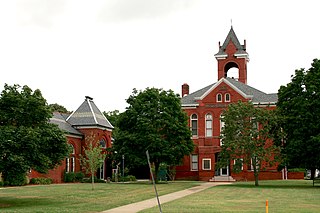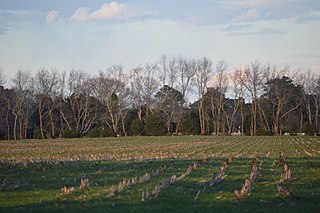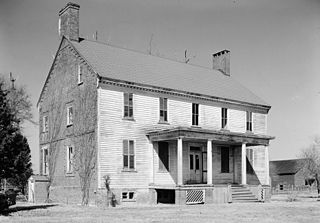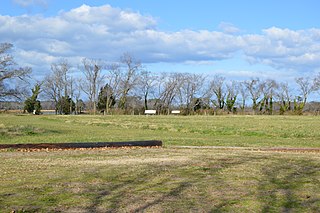
Accomack County is a United States county located in the eastern edge of the Commonwealth of Virginia. Together, Accomack and Northampton counties make up the Eastern Shore of Virginia, which in turn is part of the Delmarva Peninsula, bordered by the Chesapeake Bay and the Atlantic Ocean. Accomac is the county seat.

Accomac is a town in and the county seat of Accomack County, Virginia, United States. The population was 526 at the 2020 census.

Onancock is a town in Accomack County, Virginia, United States. The population was 1,263 at the 2010 census.

The Debtors' Prison is a historic debtors' prison in Accomac, Virginia. Constructed in 1783 as a house for the Accomack County jailer, it is the oldest public structure in the county. It was converted to use as a debtors' prison in 1824, which purpose it served until 1849. The prison was added to the Virginia Landmarks Register and the National Register of Historic Places in 1976; along with structures in Worsham and Tappahannock, both in Virginia as well, it is one of only three debtors' prisons in the country on the National Register.

Brick House, also known as Garland House or King David's Palace, is a historic home located in the village of Clifford, Amherst County, Virginia. It is a two-story Federal Style, Flemish bond brick house with a projecting pavilion. It was built about 1803 by David Shepherd Garland, later a U.S. Congressman, and measures 65 feet by 44 feet. Two additions were made during the nineteenth century; the first, about 1830, behind the east parlor and the second, about 1850, was adjacent to the dining room and the first addition.

Cokesbury United Methodist Church is a historic Methodist church located at 13 Market Street in Onancock, Accomack County, Virginia. It was built in 1854, as a one-story, Greek Revival-style temple-front frame church. It was enlarged with a four-story, Gothic Revival entrance / bell tower with spire in 1886 and remodeled in 1892–1894. Surrounding the church on two sides is the church cemetery containing a selection of marble tombstones.

Bank Building, also known as Old Mercantile Building and Eastern Shore Chamber of Commerce, is a historical commercial building located at Accomac, Virginia, Accomack County, Virginia. It was built about 1820, and it is a two-story, rectangular brick structure in the Federal style. The front facade and watertable are stuccoed. It has a gable roof and features a fanlight window above the second story door.

Bowman's Folly, is a historic home located near Accomac, Accomack County, Virginia. Captain Edmund Bowman patented the land in 1664, the current structure was built about 1815 by General John Cropper Jr., who had been born in the house in 1755. Cropper ordered it demolished and a grander building erected after construction of a hill to allow better vistas during the War of 1812. The current building has a 2+1⁄2-story, main block with a 1+1⁄2-story wing. The main block has brick ends with interior end chimneys and frame fronts on the north and south. It has a64 gable roof with dormers. The front facade features a Palladian window and pedimented entrance porch. Also on the property are a frame kitchen, now connected to the main house by a hyphen; frame dovecote, and frame privy.

Arbuckle Place is a historic home located at Assawoman, Accomack County, Virginia. It was built in 1774, and has a 1+1⁄2-story, hall and parlor plan dwelling with brick ends and frame front and back. It has a steep gable roof. The interior features complex paneling with built in cupboards and original doors and hardware. The house is a rare survivor of a once common Eastern Shore form, the small brick end house.
Bunting Place, also known as Mapp Farm and Nickawampus Farm, is a historic home and farm located at Wachapreague, Accomack County, Virginia.
Edmund Bayly House, also known as Hermitage, is a historic home located at Craddockville, Accomack County, Virginia. It was built in two stages between 1769 and 1787, and is a 1+1⁄2-story, five-bay, brick-ended frame house. It has a gable roof with dormers. The interior features fine Georgian woodwork, including an impressive parlor chimney piece with flanking cupboards, and a handsome stair. Also on the property are a contributing kitchen outbuilding, renovated for use as a guest house, and a shed.

Wharton Place is a historic home located at Mappsville, Accomack County, Virginia. It was built in 1798, and is a two-story, five-bay, brick dwelling in the Federal style. It has a one-story brick kitchen wing. It has a deck-on-hip roof and projecting interior chimneys. Also on the property is a contributing frame smokehouse. The house was built by John Wharton (1762-1811), a prosperous maritime merchant and native of Accomack County.

Pitts Neck, also known as Pitts Neck Farm, is a historic home located near New Church, Accomack County, Virginia. It consists of a two-story, five bay, brick main block connected to a 1+1⁄2-story, two-bay frame wing connected by a hyphen. The wing dates to the beginning of the 18th century and the main block to about 25–30 years later. The main block has a central passage plan and is topped by a shallow gable roof. It features a scrolled soffit of its molded brick doorway.

Shepherd's Plain, also known as Melrose, is a historic home located near Pungoteague, Accomack County, Virginia. It was built between 1755 and 1775, and is a two-story, five bay rectangular Georgian-style dwelling with brick ends with interior end chimneys and frame fronts. It measures 39 feet by 54 feet, and has a gable roof. The interior has a central passage plan and features notable paneling in the formal parlor. It was built for Edward Ker, a prominent Accomack County planter and politician.
Willowdale, also known as Smith Place, Gunther Farm, and Willow Dale, is a historic home located at Painter, Accomack County, Virginia. It is a two-story, five-bay, gambrel roofed, frame dwelling with brick ends. There is a two-bay, single story extension that provides service from a 1+1⁄2-story kitchen with a large brick cooking fireplace at the south end. The wing dates to the early-19th century. The main block is an expansion of a 17th-century patent house of 1+1⁄2 stories that now forms the parlor at the north end of the main block. The house is representative of the vernacular "big house, little house, colonnade, kitchen" style that was common in colonial homes on the Eastern Shore of Virginia. Also on the property are the contributing ruins of a barn. Willowdale is one of the few remaining examples of the dwelling of an early colonial settler, landowner and farmer. The Smith family remained owners of Willowdale from 1666 until 2018.

Hopkins and Brother Store is a historic commercial building located at Onancock, Accomack County, Virginia. It is a simple frame structure consisting of a two-storey block with a slightly lower two-storey ell and lean-to. The building features corner pilasters, a bracketed cornice, and one "Gothic" window in the attic. Hopkins and Brother was founded in 1842 by Captain Stephen Hopkins. The business remained in the hands of the Hopkins family until it was discontinued in 1965. The business served as one of the commercial and maritime trading centers of the Eastern Shore. Detailed records of the store exist from 1839 to 1965 and have been donated to the Virginia Historical Society.

Onancock Historic District is a national historic district located at Onancock, Accomack County, Virginia. The district encompasses 267 contributing buildings, 2 contributing sites, and 2 contributing objects. It includes most of the historic residential, commercial, and ecclesiastical buildings in the town of Onancock. The buildings represent a variety of popular architectural styles including the Late Victorian, Greek Revival, and Federal styles. Notable buildings include Scott Hall, Alicia Hopkins House (1830), Harmon House, Holly House (1860), Ingleside (1880s), Dr. Lewis Harmanson House (1899), Harbor Breeze (1912), First National Bank, Roseland Theatre, Market Street Methodist Church (1882), Naomi Makemie Presbyterian Church (1895), the Charles E. Cassell designed Holy Trinity Episcopal Church (1882), Onancock Town Hall, Onancock High School (1921), and Onancock Post Office (1936). Located in the district and separately listed are the Cokesbury Church, Hopkins and Brother Store and Ker Place.

Stratton Manor is a historic plantation house located near Cape Charles, Northampton County, Virginia. It was built in the third quarter of the 18th century, and is a 1+1⁄2-story, single-pile, gable roof house with a wood-frame core of three bays with brick ends. A two-story ell was added in the first quarter of the 20th century. It is a characteristic example of the 18th-century vernacular architecture distinctive of Virginia's Eastern Shore.

Arlington Archeological Site is a historic archaeological site located near Capeville, Northampton County, Virginia. It is located east of the Custis Tombs. The site includes archaeological features ranging from Accomack Plantation, the first English settlement of the Eastern Shore in 1619, to probable tenant or slave quarter features dating to the second half of the 18th century. The site also includes the foundations of Arlington mansion, established about 1670 and demolished about 1720. Arlington plantation was the ancestral home of the Custis family of Virginia. Archaeological investigations and excavations of the site were conducted in 1987-1988 and 1994.
Edward Ker Snead, a Virginia lawyer and slaveholder in Accoumack County on Virginia's Eastern Shore, became a judge in Norfolk and Portsmouth, Virginia during the Union occupation late in the American Civil War, and later was elected one of Accomack County's two delegates to the Virginia Constitutional Convention of 1868, and even later became a federal tax collector on the Eastern Shore.





















